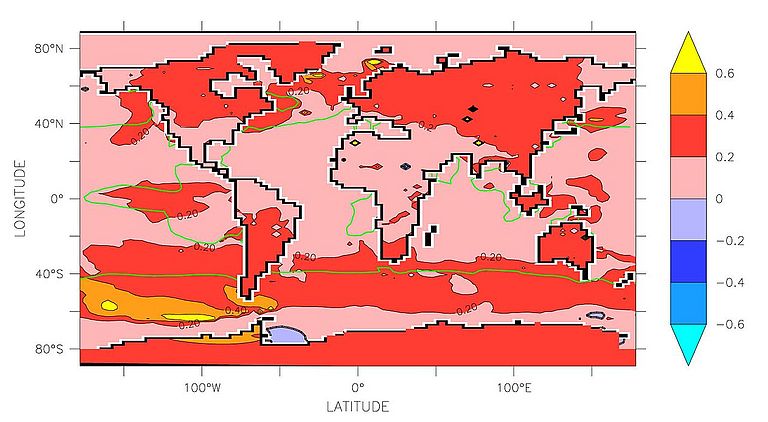CO2 Reduction by artificial ocean upwelling?
February 16, 2010/Kiel. It sounds very simple: Through (artificial) pumping of nutrient-rich water to the ocean surface the growth of alga is stimulated. The organisms take up carbon dioxide which is transported into the deep ocean. An international team of scientists under the leadership of the Leibniz Institute of Marine Sciences (IFM-GEOMAR) in Kiel, Germany examined this “Geo-engineering” concept with simulations performed by an Earth system model. The result: The benefit for “climate patient” Earth is limited and the side effects can be severe. The study was recently published in the international scientific journal Geophysical Research Letters.
It is inevitable that considerable efforts are required to keep the impacts of human-induced climate change within acceptable limits. A number of research projects investigate options for reducing atmospheric carbon dioxide (CO2) concentrations. Because a significant reduction of CO2 emissions does not appear to be politically achievable, different large-scale techniques are currently discussed as possible options for reducing the CO2 increase in the atmosphere or at least the global warming. Amongst such techniques, summarized under the heading “Geo-engineering”, are also ideas for long-term sequestration of carbon dioxide in the ocean. The effectiveness of a new method that brings up nutrient-rich water from the deep ocean to the surface using artificial pumps was recently investigated by an international team of scientists under the leadership of the Leibniz Institute of Marine Sciences (IFM-GEOMAR) in Kiel, Germany.
According to this new geo-engineering approach, nutrient-rich water should be pumped to the surface through several hundred metre long vertical plastic tubes with wave-driven flap valves drifting in the ocean. In field experiments, a manufacturer of the pumps could prove a substantial fertilizing effect, which might be economically interesting, for example for fish farming. In addition, several studies suggest a large-scale usage of the pumps to reduce atmospheric CO2: A part of the carbon-rich biomass generated through fertilization sinks to the deep ocean and reduces the CO2 content of surface water that can subsequently take up more CO2 from the atmosphere. “Besides the technical feasibility of such devices on large space and time scales, this method has, similar to other suggested approaches, a very limited sequestration potential and a risk of substantial side effects”, explains Prof. Dr. Andreas Oschlies from IFM-GEOMAR, lead author of the study. Together with colleagues from the UK and Australia, they could show in a model simulation that under very optimistic assumptions three gigatons of carbon dioxide per year could be captured. (For comparison: The global anthropogenic CO2 emissions are currently 36 gigatons per year). “In particular we were surprised that in our computer model the main effect did not happen in the ocean but on land”, explains co-author Dr. Markus Pahlow from IFM-GEOMAR. “The reason is the low temperature of the water pumped to the surface leading to a cooling of the atmosphere and subsequently to a slower decomposition of organic material in the soils”, Pahlow continues. “This effect is global and occurs even far away from the area where the pumps are used, which makes an assessment of success or failure of such a method extremely difficult in practice”, Pahlow summarizes.
“In addition, there is a second critical point: whenever the pumps stop, atmospheric CO2-concentrations and surface temperatures increase rapidly to values that are even higher than those of a control simulation that never employed the artificial pumps”, Prof. Oschlies points out. Thus, the pumps must never be halted or stopped. This resembles a bit Goethes sorcerer's apprentice: ‘Spirits that I've cited, my commands ignore’. “Even though not all interactions are known and correctly modelled, we do not see this method as a solution of our CO2 problem”, Oschlies summarizes.
Original publication:
Oschlies, A., M. Pahlow, A. Yool and R. J. Matear, 2010: Climate engineering by artificial ocean upwelling – channelling the sorcerer’s apprentice. Geophys. Res. Lett., 37, DOI:10.1029/2009GL041961.
Contact:
Dr. Andreas Villwock (Communication & Media), Phone: +49-431 600-2802, avillwock(at)ifm-geomar.de



